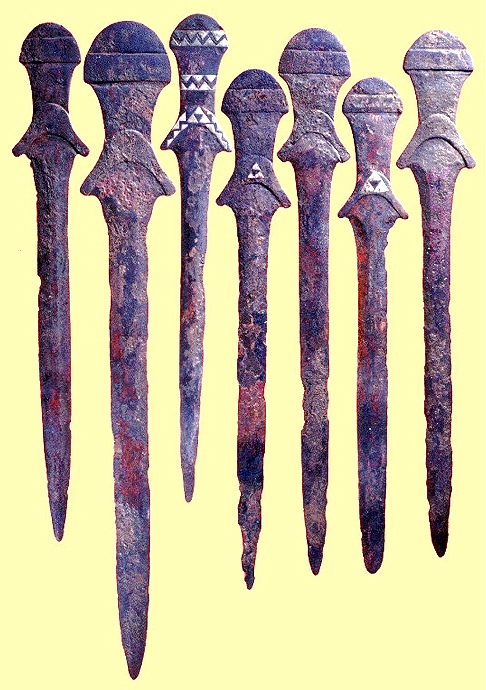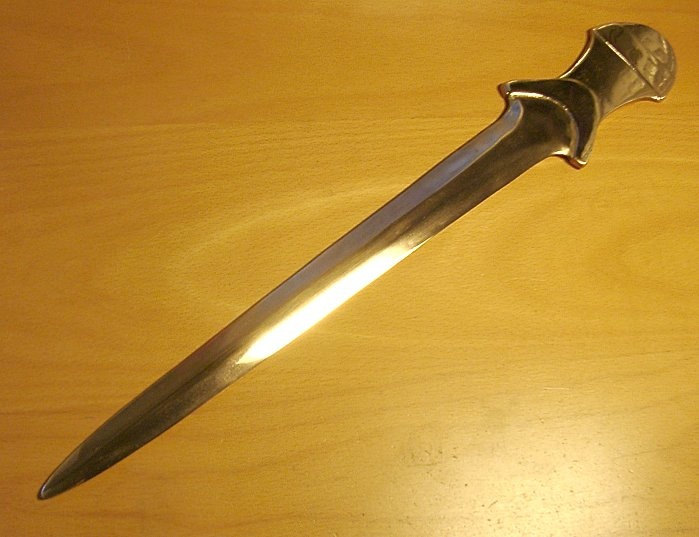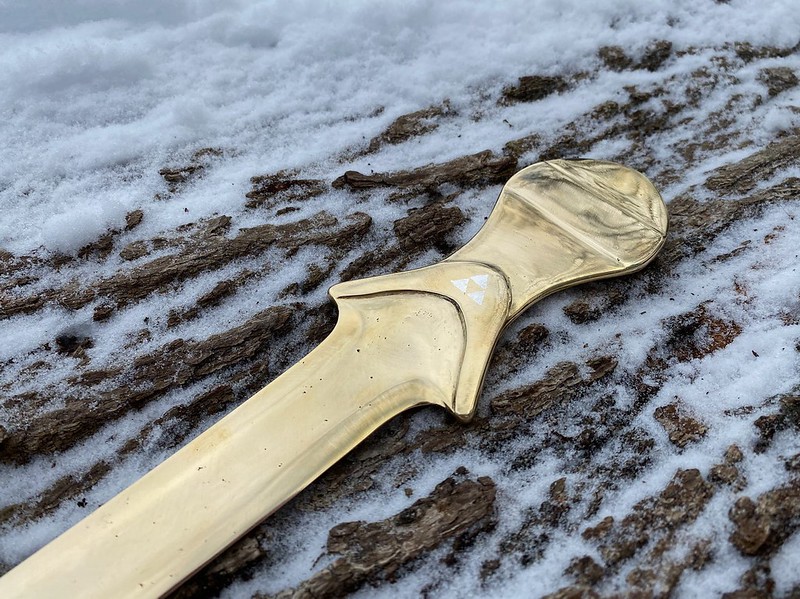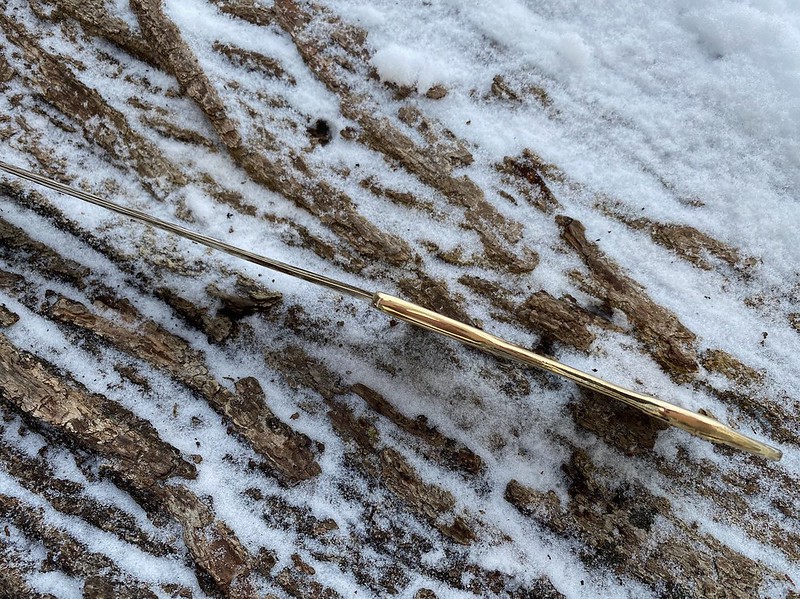| Author |
Message |
|
Joe A
Location: Philadelphia, USA Joined: 17 Oct 2013
Posts: 89
|
 Posted: Tue 15 Dec, 2020 7:16 pm Post subject: Arslantepe Sword Project Posted: Tue 15 Dec, 2020 7:16 pm Post subject: Arslantepe Sword Project |
 |
|
I'm working with an artisan to finally get one of these into my sword collection.
As you can see we do have some good examples to work with.
My understanding is they range from 45 to 60 cm.


Here's someone's reproduction. I know of at least two reproductions of this sword out there.

|
|
   |
 |
|
Joe A
Location: Philadelphia, USA Joined: 17 Oct 2013
Posts: 89
|
 Posted: Tue 15 Dec, 2020 7:23 pm Post subject: Posted: Tue 15 Dec, 2020 7:23 pm Post subject: |
 |
|
Here's what we have so far. The final product will be bronze of course. I'm thinking the blades need to be a bit wider and the grip thicker, but I am quite open to any and all suggestions.





|
|
   |
 |
Dan Howard

|
 Posted: Tue 15 Dec, 2020 8:32 pm Post subject: Posted: Tue 15 Dec, 2020 8:32 pm Post subject: |
 |
|
Nice project. IIRC the originals were made from arsenic-copper rather than bronze. If you use bronze they won't look right.
Author: Bronze Age Military Equipment, Pen and Sword Books
|
|
  |
 |
|
Joe A
Location: Philadelphia, USA Joined: 17 Oct 2013
Posts: 89
|
 Posted: Wed 16 Dec, 2020 7:37 pm Post subject: Posted: Wed 16 Dec, 2020 7:37 pm Post subject: |
 |
|
| Dan Howard wrote: | | Nice project. IIRC the originals were made from arsenic-copper rather than bronze. If you use bronze they won't look right. |
Thanks Dan, I was hoping this would catch your eye. Arsenic-copper is not a viable option as I want my maker to live a long and happy life. I'm not even sure what such an alloy would look like in the mixture these swords used when all shined up. We have to make accommodations, as we both know, when the most accurate metals are simply not available.
So aside from all that what about the dimensions???
Simply using actual artifacts as guides can be problematic. Many years ago Matt Lukes told me he thought that some swords we think were not leaf type blades were when new, and constant sharpening had some effect on the shape of the blades over time. An archaeologist at the Penn Museum echoed that idea, that we need to recognize that some artifact sword blades could be thinned out over time due to constant sharpening giving us the false impression that they were produced to be that way.
I don't know for sure, what do you think in regards to these specific swords??? Would a thin arsenic-copper blade be durable enough to be effective as a sword? Are these even actual swords to poke your enemy with or votive objects?
|
|
   |
 |
Dan Howard

|
 Posted: Thu 17 Dec, 2020 4:33 am Post subject: Posted: Thu 17 Dec, 2020 4:33 am Post subject: |
 |
|
They were functional swords. Arsenic hardens copper just like tin does. The arsenic wasn't deliberately added, it was an impurity in the ore. They worked out early on that some ore deposits produced better weapons than others.
Jeroen made three replicas a few years ago. He used tin instead of arsenic. One of his photos is in my book.
https://www.bladesmithsforum.com/index.php?/topic/12946-reproduction-of-the-oldest-swords-in-the-world/
Author: Bronze Age Military Equipment, Pen and Sword Books
|
|
  |
 |
|
Joe A
Location: Philadelphia, USA Joined: 17 Oct 2013
Posts: 89
|
 Posted: Thu 17 Dec, 2020 10:14 am Post subject: Posted: Thu 17 Dec, 2020 10:14 am Post subject: |
 |
|
I asked him if he was interested in making more some time ago and he was not. Too bad his website is gone as none of the image links worked for me.
This passage is what intrigues a lot of archaeologists "it's mysterious that no other swords are found prior or after these examples. Only short daggers are known from the 5 millenium BC onwards, generally under 20cm in length."
Generally when a "revolutionary" advance is made in a thing that gives a society a military advantage it is copied by it's neighbors, and often improved upon. Either these swords did not have much of an impact, or are not actual swords.
If these are "bling" that indicated status of some sort...it did seem to catch on.
I don't know enough about what folks were killing their enemies with at that time and in that place to say that these are not swords, my uninformed opinion is it IS a sword, not a votive object as it was found with other weapons.
The really thin grip is problematic. It seems awkward to hold, but I won't know for sure til I hold one.
Dan, please take a look at the dimensions I posted above. Do you think they are good???
Anybody else have any comments on the dimensions?
|
|
   |
 |
Dan Howard

|
 Posted: Thu 17 Dec, 2020 12:54 pm Post subject: Posted: Thu 17 Dec, 2020 12:54 pm Post subject: |
 |
|
I wouldn't make a replica just by looking at the dimensions. I would want to talk to someone who had personally handled the original.
Author: Bronze Age Military Equipment, Pen and Sword Books
|
|
  |
 |
|
Dan D'Silva
|
 Posted: Thu 17 Dec, 2020 1:53 pm Post subject: Posted: Thu 17 Dec, 2020 1:53 pm Post subject: |
 |
|
|
Jeroen discussed the grip on the thread for these at SFI at the same time. He described holding it as "a bit odd, as it's such a thin hilt, but it's not bad. It's kinda like holding on to a ruler."
|
|
  |
 |
|
Joe A
Location: Philadelphia, USA Joined: 17 Oct 2013
Posts: 89
|
 Posted: Thu 17 Dec, 2020 2:02 pm Post subject: Posted: Thu 17 Dec, 2020 2:02 pm Post subject: |
 |
|
| Dan Howard wrote: | | I wouldn't make a replica just by looking at the dimensions. I would want to talk to someone who had personally handled the original. |
We make replicas every day based on sketchy fragments of data and the best available resources. You own the best Bronze Age Armour in the world, in brass rather than bronze as sheets of thin bronze ain't for sale and Jeff ain't gonna make his own bronze sheet. We have make such accommodations and it should not shackle anyone's desire for the best available example they can afford.
Nobody with a brain is going to add arsenic into any bronze mix just so we can say, it's "authentic." Frankly, I would not even ask even someone was willing.
Most of us don't know anyone with access to the originals and even if we did, as I do as the Penn Museum has a large operation in Turkey at Gordion I can say with certainty that there is no consensus among those who have handled these objects regarding what they are and what they were actually used for.
Why is that? I'd say none of them are into swords as WEAPONS, they see these things as part of the material culture and seek to understand the cultural context of the object.
We here on the other hand are into swords, we know what makes a thing a sword, what makes a thing that looks kinda like a sword not a real sword and what real swords could be made from. If there is a question about swords I need answered here is where I come first.
Folks here know a lot about swords I'd say so please speak up.
|
|
   |
 |
Paul Hansen

|
 Posted: Sun 27 Dec, 2020 9:53 am Post subject: Posted: Sun 27 Dec, 2020 9:53 am Post subject: |
 |
|
| Joe A wrote: | Why is that? I'd say none of them are into swords as WEAPONS, they see these things as part of the material culture and seek to understand the cultural context of the object.
We here on the other hand are into swords, we know what makes a thing a sword, what makes a thing that looks kinda like a sword not a real sword and what real swords could be made from. If there is a question about swords I need answered here is where I come first. |
That's an astute and unfortunate characterisation of many archeologists...
I happen to have one of Jeroen Zuiderwijk's reproductions of one of the Arslantepe swords. I'm fairly certain that the bottom sword in the first post is also made by Jeroen. But mine has beautiful silver inlays. 
Jeroen did use a 4% tin bronze as equivalent to the arsenic bronze. Jeroen told me that by adding 4% tin, the result should have equivalent hardness and other material properties as the originals. He knows a lot about bronze working so I have no reason to doubt him.
The sword is beautiful and spends it's days hanging here on my wall, just like the originals apparently. 
I did cut something with it at some point, either a plastic milk bottle or a card board box. It performed well enough, but it did leave a small mark on the blade. I polished that out again, but I didn't cut with it again.
Anyway, it's a fully functional weapon. Although it is clearly inferior to even later bronze swords, like the Ewart Park or Naue II types, both in terms of material composition and in terms of design. Nevertheless I imagine that a well trained army could make really good use of the Arslantepe type sword when faced with opponents armed only with spears.
The flat hilt, well, obviously there are more comfortable hilts but it doesn't impair function too much. The same for the balance: it's POB is very close to the hand. Holding it in a hammer grip seems the most secure way, but it makes cutting feel a bit unnatural. Holding it in a sabre grip, with the thumb against the "crossguard" feels much better for cutting. But again, this sword was so far ahead of it's time that it's unfair to compare them with Late Bronze Age swords, which were obviously better designed.
|
|
  |
 |
Paul Hansen

|
 Posted: Mon 28 Dec, 2020 11:00 am Post subject: Posted: Mon 28 Dec, 2020 11:00 am Post subject: |
 |
|
| Joe A wrote: | | Most of us don't know anyone with access to the originals and even if we did, as I do as the Penn Museum has a large operation in Turkey at Gordion I can say with certainty that there is no consensus among those who have handled these objects regarding what they are and what they were actually used for. |
One other remark. It's probably off-topic but it does annoy me to no end.
The man who designed and made these swords was further ahead of his time than Leonardo da Vinci.
Contrary to Leonardo, he actually made something that worked.
Yet despite the fact that nearly all of Leonardo's inventions, in particular his flying machines, never worked and can never work, he's universally acclaimed as one of humanities biggest geniuses.
But the unnamed sword maker who dreamt of these swords and found a way to make them is not only unknown to the masses but people who are actually aware of his work think these swords "may have been for votive purpose only" or "decoration" or "display of wealth". Or that "they made something they didn't understand".
What these people somehow fail to understand that a weapon, although it may be used in a gruesome manner by some, is intended for the protection of ones family, people and country. One would hope and think that logic would be part of any university's curriculum but apparently not...
End rant. Again, sorry for going off-topic....
|
|
  |
 |
|
Joe A
Location: Philadelphia, USA Joined: 17 Oct 2013
Posts: 89
|
 Posted: Wed 30 Dec, 2020 7:02 am Post subject: Posted: Wed 30 Dec, 2020 7:02 am Post subject: |
 |
|
|
Thanks everyone! Much appreciate the advice both private and public. I will post the results when the sword is ready.
|
|
   |
 |
|
Joe A
Location: Philadelphia, USA Joined: 17 Oct 2013
Posts: 89
|
 Posted: Wed 30 Dec, 2020 7:17 am Post subject: Posted: Wed 30 Dec, 2020 7:17 am Post subject: |
 |
|
|
Paul, what about these swords being symbols of authority? Functional as weapons, but perhaps their primary purpose was to signal that the wielder was the leader. Of course I am speculating, but what comes to mind is my own experiences. Back in 1980 when I was a very young US Marine I asked my platoon leader why he only carried a small .45 caliber pistol rather than an M-16 and he laughed saying that it's to let everyone "know who the boss was." He then went on to explain that unlike the Army Marine officers spent a lot of time practicing with the "Mameluke Sword" which he then went on to say was as useful in battle as marching slowly in tight formations, which we did a lot of back then...lol.
|
|
   |
 |
Paul Hansen

|
 Posted: Sun 03 Jan, 2021 12:00 pm Post subject: Posted: Sun 03 Jan, 2021 12:00 pm Post subject: |
 |
|
| Joe A wrote: | | Paul, what about these swords being symbols of authority? Functional as weapons, but perhaps their primary purpose was to signal that the wielder was the leader. |
Of course it's possible (and appropriate for a European middle / late bronze age context) but I'd say that in order to become a symbol, people must first be familiar with the thing. Which they likely weren't because they seem to be a quite isolated development. Unless you mean it in a "my dagger is bigger than your dagger" kind of way.
But what is interesting is that the most lavishly decorated swords are among the smaller end of the swords found. If we assume that decoration equals status, then probably length doesn't give more status.
Possibly a bit of topic (again) but if you search for the word "sword" in the Bible, then the Old Testament yields mainly results where swords are either a threat like "the Assyrians will come with swords" or factual statements like "Ehud had a sword". The New Testament on the other hand contains many references where the sword is seen as a symbol, e.g. in Paul's letters or in Revelations. My interpretation is that in the Old Testament context, which is a near-Eastern, bronze age / iron age context, a sword is mostly just a sword. It's a rather huge step from the Old Testament to whatever culture the people who lived in Arslantepe belonged to, but there are some notable similarities between the Old Testament and Sumerian / Babylonian legends, so maybe it can provide some sense of context. https://www.bible.com/search/bible?q=sword
|
|
  |
 |
|
Joe A
Location: Philadelphia, USA Joined: 17 Oct 2013
Posts: 89
|
 Posted: Thu 21 Jan, 2021 5:57 am Post subject: Posted: Thu 21 Jan, 2021 5:57 am Post subject: |
 |
|
Here below are the first efforts and for the price you simply can't go wrong. For sword aficionados, it's a great conversation piece. There are some legal issues in Ukraine I'm told about making and shipping a "real sword" so you will have to discuss that with the maker.
They made the models using a 3D printer and I was actually hoping they would make the sword that way as well, but no...sand casting. Using modern technology to make one of the earliest swords would have been so cool in a classroom setting. Museums are starting to experiment with "printing" 3D swords or at least some of the fittings.
Regarding the bronze, the originals were made of "arsenic bronze" and at least one of better reproductions made some years ago used tin bronze as a substitute. Low tin bronze, as we all know, creates a reddish color that becomes more "golden" as the tin content rises. The maker of these swords tells me they use aluminum bronze and they are stuck with that for now. As you can see below that type of bronze creates a more "golden" hue. I don't know what color the original swords were, only that they were apparently made with arsenic rather than tin. On the Wikipedia page there is an example of what such objects might have looked like compared to tin-copper bronze https://en.wikipedia.org/wiki/Arsenical_bronze. Note the silvery color is achieved with higher levels of arsenic than is needed to simply make the alloy suitable for creating a useful and durable edge.
As all our ancient pieces are some level of compromise, it's whatever makes one happy in the end.





|
|
   |
 |
Paul Hansen

|
 Posted: Sun 24 Jan, 2021 6:25 am Post subject: Posted: Sun 24 Jan, 2021 6:25 am Post subject: |
 |
|
Looking pretty good Joe!
The inlay looks particularly nice!
The only comments I have:
- There is some indication of porosity in the shorter one
- The aluminium bronze is a pity
I'd be really interested to see it's weight, and how it will do in test cutting (assuming you want to do that).
|
|
  |
 |
|
Joe A
Location: Philadelphia, USA Joined: 17 Oct 2013
Posts: 89
|
 Posted: Sun 24 Jan, 2021 10:42 am Post subject: Posted: Sun 24 Jan, 2021 10:42 am Post subject: |
 |
|
Due to legal concerns it can only arrive blunt and as it's not the historical bronze mix...I don't really know what sharpness would add to our knowledge of such weapons, but I do plan to sharpen it and see, lol.
It will be interesting to hold it and handle it moving around, but that's about it I'm sad to say. I'll take it out and let the school kids play with it to hopefully spark their interest in ancient history, metals and how usable technological advances can sometimes just stop. Progress is never a straight line I teach and at times the best ideas lose.
As a sword collector this one is more an object of conversation than anything else. PM me for contact information. At $260 US dollars for the short version WITH the silver inlay INCLUDING international shipping I think every sword aficionado should have one! Delivery is in days not months or years as well.
It will be the first sword on the table now:

|
|
   |
 |
Dan Howard

|
 Posted: Sun 24 Jan, 2021 12:10 pm Post subject: Posted: Sun 24 Jan, 2021 12:10 pm Post subject: |
 |
|
It is a pretty nice job. You should be proud of it. And the price is a bargain. The colour is irrelevant when trying to determine how it might function.
The original smiths had no choice in the arsenic content. It was already present in the ore. Arsenic doesn't seem to have been deliberately added as an alloying element.
Author: Bronze Age Military Equipment, Pen and Sword Books
|
|
  |
 |
|
|

